Links to usage instructions
Double meter tests | Single meter tests | Extremity tests
Please note that the needle color in the 2018 Petrometer models have been changed from yellow to black.
1. Cervical Rotation - Neutral
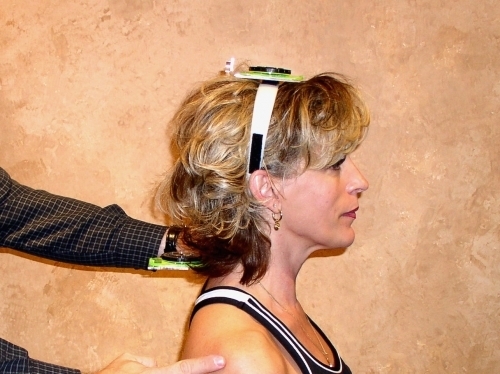 Set patient in starting position. Place meter on the headband. Line up "Zero" degrees with "red" needle. Place the second meter at the T-1 level and line up "Zero" with the "red" needle as well.
Set patient in starting position. Place meter on the headband. Line up "Zero" degrees with "red" needle. Place the second meter at the T-1 level and line up "Zero" with the "red" needle as well.
2. Cervical Rotation - Rotated
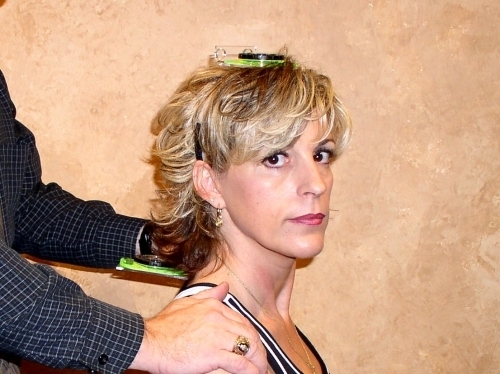 Rotate head to the right. Subtract the T-1 meter's reading from the upper meter's reading to get the right rotation test results. Rotate head to left without resetting meter and subtract T-1 readings from the upper meter's reading for the left rotation test results.
Rotate head to the right. Subtract the T-1 meter's reading from the upper meter's reading to get the right rotation test results. Rotate head to left without resetting meter and subtract T-1 readings from the upper meter's reading for the left rotation test results.
3. Cervical Lateral Flextion - Neutral
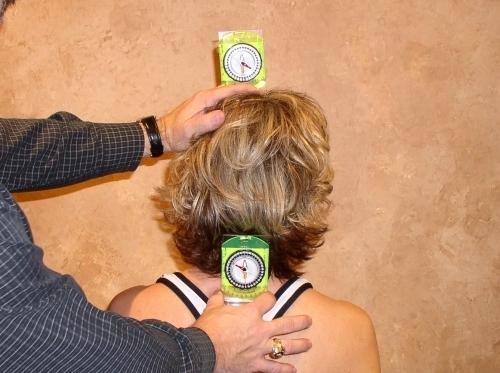 Place the upper Petrometer on the center of the head. Using the black needle "Zero" the meter out with the patient in the neutral position. Place the base of the second Petrometer at T-1 level and "Zero" it out.
Place the upper Petrometer on the center of the head. Using the black needle "Zero" the meter out with the patient in the neutral position. Place the base of the second Petrometer at T-1 level and "Zero" it out.
4. Cervical Lateral Flexion - Flexed
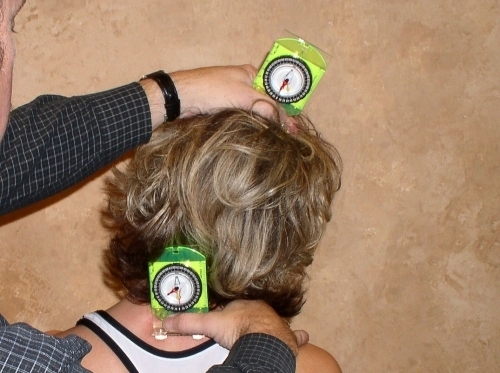 Instruct the patient to flex right and then left, taking the reading of both meters at the end of patient movement in each direction. Subtract the bottom angle from the top to obtain the true flexion of each test.
Instruct the patient to flex right and then left, taking the reading of both meters at the end of patient movement in each direction. Subtract the bottom angle from the top to obtain the true flexion of each test.
5. Cervical Flexion/Extension - Neutral
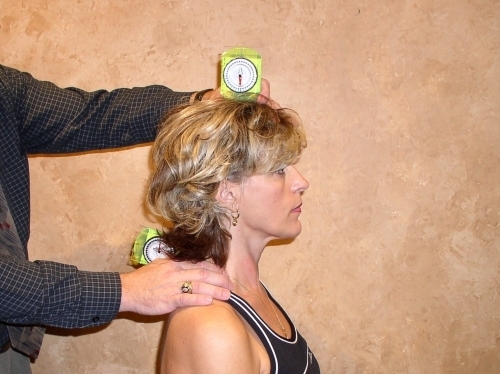 Place meter between fingers and secure the patient in the starting position. Line up "Zero" degrees with black needle. Place the second meter at T-1 and line up its black needle at "Zero" degrees as well. (A headset can be used to secure the upper meter for testing if you desire).
Place meter between fingers and secure the patient in the starting position. Line up "Zero" degrees with black needle. Place the second meter at T-1 and line up its black needle at "Zero" degrees as well. (A headset can be used to secure the upper meter for testing if you desire).
6. Cervical Flexion
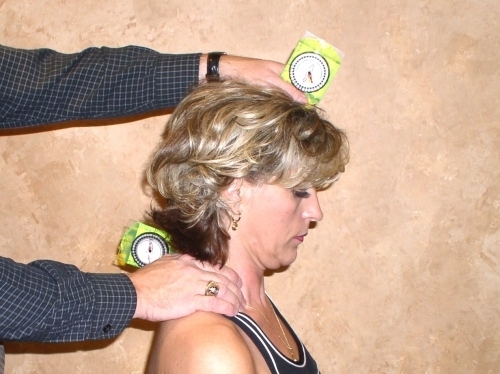 Secure the patient and flex cervicals without bending the neck forward. Read the test results from the black needles of the two meters. Subtract the T-1 meter`s readings from the findings of the upper meter. This will give you the degrees of cervical flexion.
Secure the patient and flex cervicals without bending the neck forward. Read the test results from the black needles of the two meters. Subtract the T-1 meter`s readings from the findings of the upper meter. This will give you the degrees of cervical flexion.
7. Cervical Extension
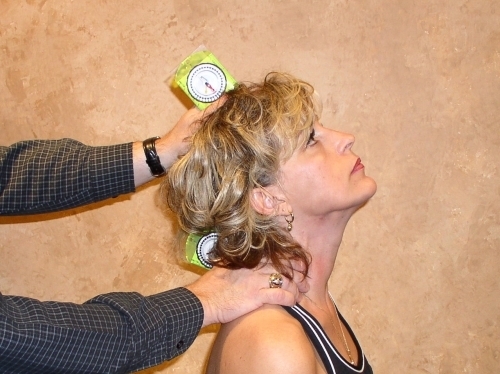 Do not move or "Zero-out" meter if flexion test was just done. Secure the patient and extend cervicals. Read the test results from the black needles of the two meters. Subtract the T-1 meter reading from the upper meter`s findings. This will give you the degrees of extension for the cervical area.
Do not move or "Zero-out" meter if flexion test was just done. Secure the patient and extend cervicals. Read the test results from the black needles of the two meters. Subtract the T-1 meter reading from the upper meter`s findings. This will give you the degrees of extension for the cervical area.
8. Thoracic Rotation-Neutral
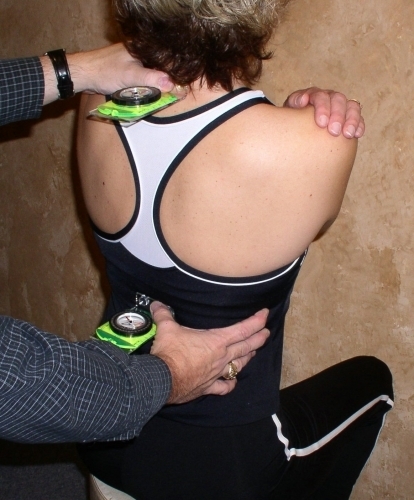 Place the patient in the sitting or standing position with their head facing straight ahead. Place the base portion of the upper meter parallel to the floor at the T-1 vertabra. "Zero" the meter`s "red" needle out while position on the patient in their neutral position. Place the base of the second meter at the L-1 area and "Zero" out the "red" needle as well.
Place the patient in the sitting or standing position with their head facing straight ahead. Place the base portion of the upper meter parallel to the floor at the T-1 vertabra. "Zero" the meter`s "red" needle out while position on the patient in their neutral position. Place the base of the second meter at the L-1 area and "Zero" out the "red" needle as well.
9. Thoracic Rotation- Rotated
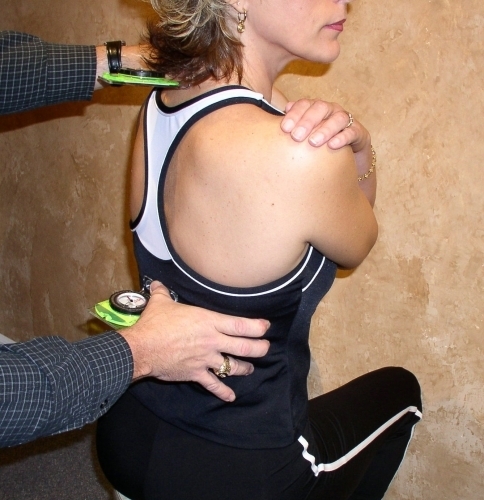 Instruct the patient to rotate right and then left, taking the readings of both meters at the end of patient movement in each direction. Subtract the bottom meters reading from the top meters reading to obtain the true degree of movement for each direction.
Instruct the patient to rotate right and then left, taking the readings of both meters at the end of patient movement in each direction. Subtract the bottom meters reading from the top meters reading to obtain the true degree of movement for each direction.
10. Thoracic Lateral Flexion-Neutral
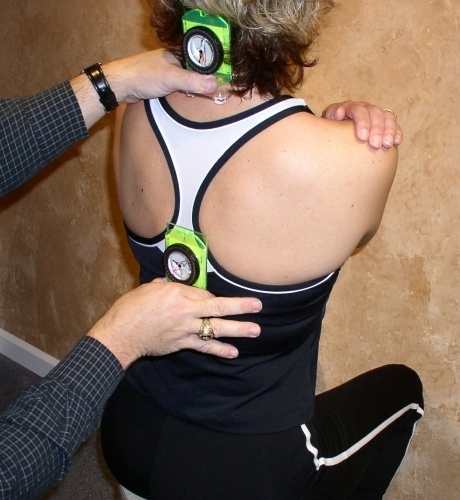 Place the patient in the sitting or standing position with their head facing straight ahead. Place the first meter at T-1 area perpendicular to the floor. "Zero" the meter`s black needle out. Place the base of the second Petrometer at L-1 and "Zero" out the black meter as well.
Place the patient in the sitting or standing position with their head facing straight ahead. Place the first meter at T-1 area perpendicular to the floor. "Zero" the meter`s black needle out. Place the base of the second Petrometer at L-1 and "Zero" out the black meter as well.
11. Thoracic Lateral Flexion-Flexed
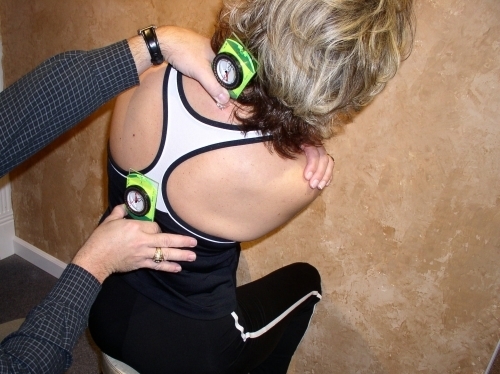 Instruct the patient to flex to the right and then to the left, taking the readings of both meters at the end of patient movement in each direction. Subtract the bottom angle from the top to obtain the true degree of movement for each test.
Instruct the patient to flex to the right and then to the left, taking the readings of both meters at the end of patient movement in each direction. Subtract the bottom angle from the top to obtain the true degree of movement for each test.
12. Thoracic Flexion/Extention-Neutral
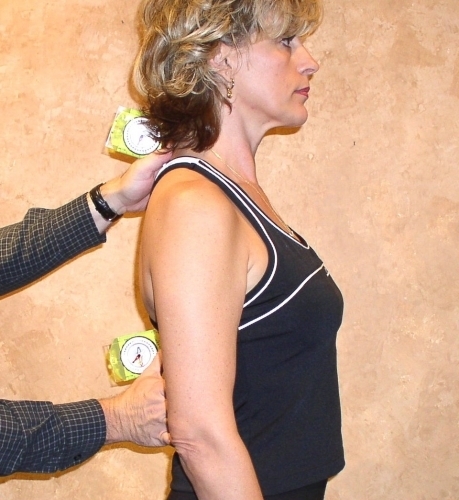 Place the patient in the sitting or standing position with their head facing straight ahead. Center the first Petrometer perpendicular from the floor over T-1 area and "Zero" the black needle out. Place the second Petrometer perpendicular to the over L-1 area and "Zero" the black needle out.
Place the patient in the sitting or standing position with their head facing straight ahead. Center the first Petrometer perpendicular from the floor over T-1 area and "Zero" the black needle out. Place the second Petrometer perpendicular to the over L-1 area and "Zero" the black needle out.
13. Thoracic Flexion
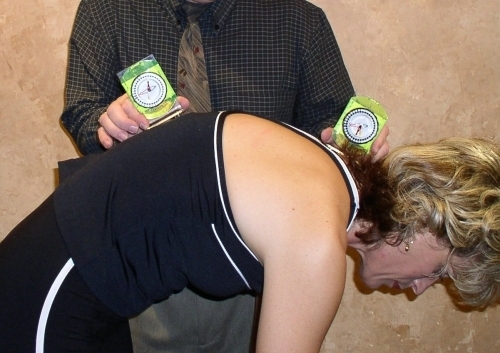 Instruct the patient to flex forward and then take the readings from both meters at the end of patient`s movement. Subtract the bottom angle from the top to obtain the true degree of movement.
Instruct the patient to flex forward and then take the readings from both meters at the end of patient`s movement. Subtract the bottom angle from the top to obtain the true degree of movement.
14. Thoracic Extention
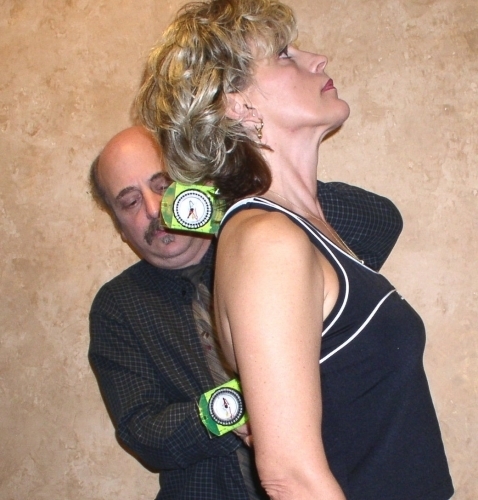 Instruct the patient to extend backwards and then take the readings from both meters at the end of patient`s movement. Subtract the bottom angle from the top to obtain the true degree of movement.
Instruct the patient to extend backwards and then take the readings from both meters at the end of patient`s movement. Subtract the bottom angle from the top to obtain the true degree of movement.
15. Lumbar Rotation-Neutral
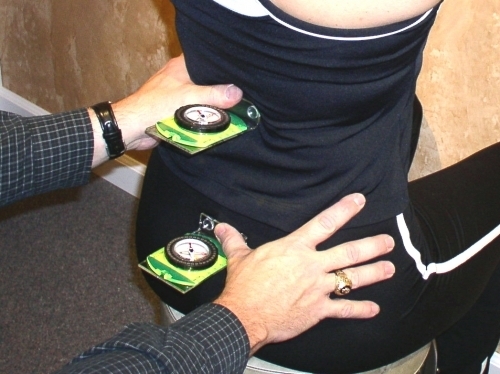 Place the patient in the sitting or standing position with their head facing straight ahead. Place the first Petrometer parallel to the floor at the L-1 area of the patient. "Zero" out the meter`s "Red" needle while the patient is in their neutral position. Place the base of the second meter at the S-2 area and "Zero" out that meter`s "Red" needle as well.
Place the patient in the sitting or standing position with their head facing straight ahead. Place the first Petrometer parallel to the floor at the L-1 area of the patient. "Zero" out the meter`s "Red" needle while the patient is in their neutral position. Place the base of the second meter at the S-2 area and "Zero" out that meter`s "Red" needle as well.
16. Lumbar Rotation-Rotated
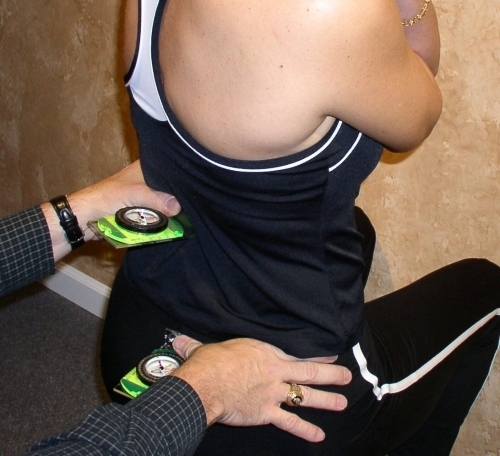 Instruct the patient to rotate right and then left, taking the readings of both meters at the end of patient movement in each direction. Subtract the bottom meters reading from the top meters reading to obtain the true degree of movement for each direction.
Instruct the patient to rotate right and then left, taking the readings of both meters at the end of patient movement in each direction. Subtract the bottom meters reading from the top meters reading to obtain the true degree of movement for each direction.
17. Lumbar Lateral Flexion-Neutral
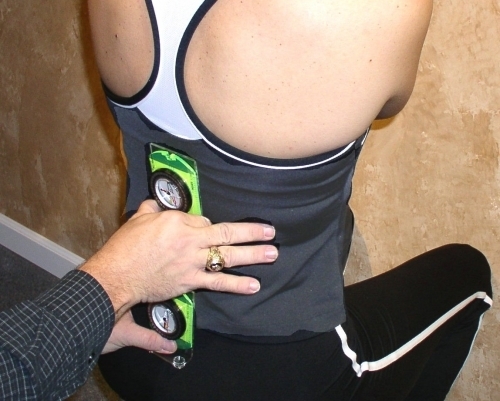 Place the patient in the sitting or standing position with their head facing straight ahead. Place the first Petrometer perpendicular to the floor over the L-1 area and "Zero" the meter`s black needle out. Place the second Petrometer over the S-2 area and "Zero" the meter`s black needle out as well.
Place the patient in the sitting or standing position with their head facing straight ahead. Place the first Petrometer perpendicular to the floor over the L-1 area and "Zero" the meter`s black needle out. Place the second Petrometer over the S-2 area and "Zero" the meter`s black needle out as well.
18. Lumbar Lateral Flexion-Flexed
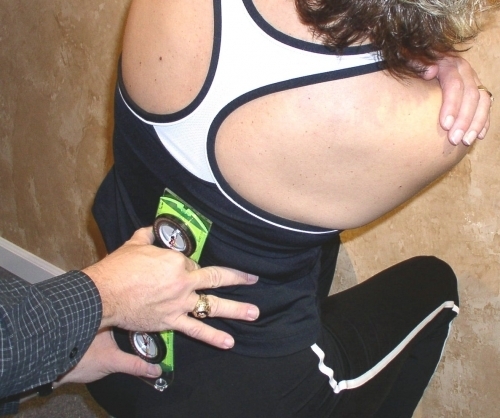 Instruct the patient to flex to the right and then take the readings from both meters at the end of patient`s movement. Now flex the patient to the left without resetting the meters. Subtract the bottom angle from the top to obtain the true degree of movement for each test.
Instruct the patient to flex to the right and then take the readings from both meters at the end of patient`s movement. Now flex the patient to the left without resetting the meters. Subtract the bottom angle from the top to obtain the true degree of movement for each test.
19. Lumbar Flexion/Extention-Neutral
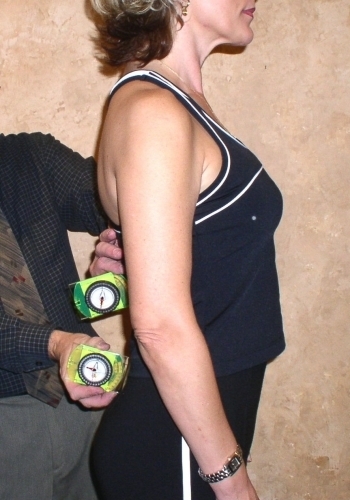 Place the patient in the sitting or standing position with their head facing straight ahead. Center the first Petrometer perpendicular to the floor over the L-1 area and "Zero" the meter`s black needle out. Place the second Petrometer over the S-2 area and "Zero" the meter`s black needle out as well.
Place the patient in the sitting or standing position with their head facing straight ahead. Center the first Petrometer perpendicular to the floor over the L-1 area and "Zero" the meter`s black needle out. Place the second Petrometer over the S-2 area and "Zero" the meter`s black needle out as well.
20. Lumbar Flexion
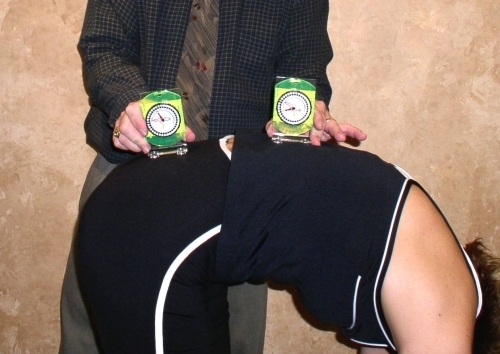 Instruct the patient to flex forward and then take the readings from both meters at the end of patient`s movement. Subtract the bottom angle from the top to obtain the true degree of movement.
Instruct the patient to flex forward and then take the readings from both meters at the end of patient`s movement. Subtract the bottom angle from the top to obtain the true degree of movement.
21. Lumbar Extention
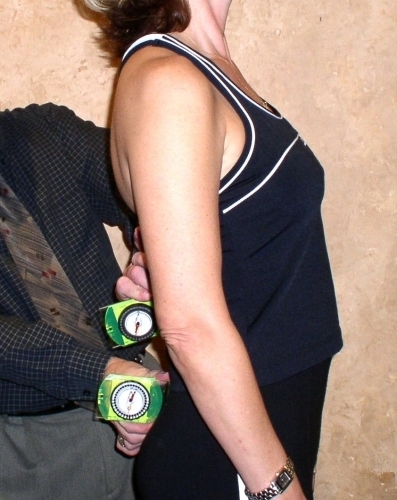 With the same meter placements as lumbar flexion instruct the patient to extend backwards and then take the readings from both meters at the end of patient`s movement. Subtract the bottom angle from the top to obtain the true degree of movement.
With the same meter placements as lumbar flexion instruct the patient to extend backwards and then take the readings from both meters at the end of patient`s movement. Subtract the bottom angle from the top to obtain the true degree of movement.
We are currently in the process of upgrading the Petrometer product. If you would like to be informed when the new edition is available, please follow the steps below, and we will contact you when the time arrives.
Thank you.
Dr. Mike Petragallo
